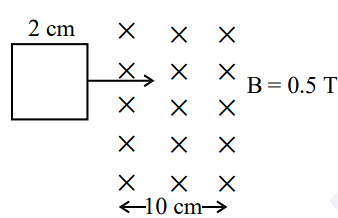Question:
The normal magnetic flux passing through a coil changes with time according to the equation $\phi = 6t^2 - 5t + 1$. What is the magnitude of the induced current at $t = 0.253\, s$ and resistance $10 \, \Omega $ ?
The normal magnetic flux passing through a coil changes with time according to the equation $\phi = 6t^2 - 5t + 1$. What is the magnitude of the induced current at $t = 0.253\, s$ and resistance $10 \, \Omega $ ?
Updated On: May 12, 2024
- 1.2 A
- 0.8 A
- 0.6 A
- 0.2 A
Hide Solution
Verified By Collegedunia
The Correct Option is D
Solution and Explanation
Here ,
Magnetic flux, $\phi = 6t^2 - 5t + 1$
Resistance, $R = 10\, \Omega$
The induced emf is
$\varepsilon = - \frac{d\phi}{dt} = - \frac{d}{dt} \left(6t^{2} - 5t+ 1\right)=-\left(12t - 5 \right) $
At $t = 0.253 \,s$
$\varepsilon = -(12 \times 0.253 - 5 ) = 1.964 \, V = 2 V$
$\therefore$ Induced current, $ I = \frac{ \varepsilon}{R} = \frac{2}{10} = 0.2 A$
Magnetic flux, $\phi = 6t^2 - 5t + 1$
Resistance, $R = 10\, \Omega$
The induced emf is
$\varepsilon = - \frac{d\phi}{dt} = - \frac{d}{dt} \left(6t^{2} - 5t+ 1\right)=-\left(12t - 5 \right) $
At $t = 0.253 \,s$
$\varepsilon = -(12 \times 0.253 - 5 ) = 1.964 \, V = 2 V$
$\therefore$ Induced current, $ I = \frac{ \varepsilon}{R} = \frac{2}{10} = 0.2 A$
Was this answer helpful?
0
0
Top Questions on Faradays laws of induction
- The magnetic flux \(\phi\) (in weber) linked with a closed circuit of resistance \(8 \, \Omega\) varies with time (in seconds) as \(\phi = 5t^2 - 36t + 1\). The induced current in the circuit at \(t = 2 \, \text{s}\) is ______ A.
- JEE Main - 2024
- Physics
- Faradays laws of induction
- In a coil, the current changes form –2 A to +2A in 0.2 s and induces an emf of 0.1 V. The self-inductance of the coil is :
- JEE Main - 2024
- Physics
- Faradays laws of induction
- A square loop of side 2 cm enters a magnetic field with a constant speed of 2 cm s-1 as shown. The front edge enters the field at t = 0s. Which of the following graph correctly depicts the induced emf in the loop?
( Take clockwise direction positive )
- KCET - 2023
- Physics
- Faradays laws of induction
- A metallic rod of length 1 m held along east-west direction is allowed to fall down freely. Given horizontal component of earth’s magnetic field BH = 3 × 10-5 T. The emf induced in the rod at an instant t = 2s after it is released is ( Take g = 10 ms-2 )
- KCET - 2023
- Physics
- Faradays laws of induction
- The current following through an inductance coil of self inductance 6 mH at different time instants is as shown. The emf induced between t = 20s and t = 40s is nearly

- KCET - 2021
- Physics
- Faradays laws of induction
View More Questions
Questions Asked in COMEDK UGET exam
- The magnetic flux linked with a coil is given by the equation: $ \phi = 8t^2 + t + 10 $ The e.m.f. induced in the coil in the 3rd second will be
- COMEDK UGET - 2024
- Electromagnetic induction
- A satellite is revolving around the earth in a circular orbit with kinetic energy of $1.69 \times 10^{10}$ J. The additional kinetic energy required for just escaping into the outer space is
- COMEDK UGET - 2024
- Escape Speed
A solid cylinder of mass 2 kg and radius 0.2 m is rotating about its own axis without friction with angular velocity 5 rad/s. A particle of mass 1 kg moving with a velocity of 5 m/s strikes the cylinder and sticks to it as shown in figure.

The angular velocity of the system after the particle sticks to it will be:- COMEDK UGET - 2024
- The Angular Momentum
- In a given semiconductor, the ratio of the number density of electron to number density of hole is 2 : 1. If $ \frac{1}{7} $th of the total current is due to the hole and the remaining is due to the electrons, the ratio of the drift velocity of holes to the drift velocity of electrons is :
- COMEDK UGET - 2024
- Semiconductors
- A transformer which steps down 330 V to 33 V is to operate a device having impedance 110 $\Omega$. The current drawn by the primary coil of the transformer is:
- COMEDK UGET - 2024
- Transformers
View More Questions
Concepts Used:
Faradays Laws of Induction
There are two laws, given by Faraday which explain the phenomena of electromagnetic induction:
Faraday's First Law:
Whenever a conductor is placed in a varying magnetic field, an emf is induced. If the conductor circuit is closed, a current is induced, known as the induced current.
Faraday's Second Law:
The Emf induced inside a coil is equal to the rate of change of associated magnetic flux.
This law can be mathematically written as:
∈\(-N {\triangle \phi \over \triangle t}\)
